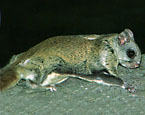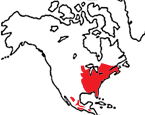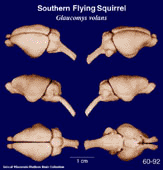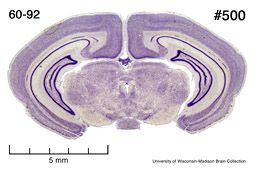|
Southern Flying
Squirrel
(Glaucomys volans) #60-92 |
||||
|
|
Physical
characteristics and distribution
|
|
The Southern Flying Squirrel resembles other squirrels except that it has a hairy fold of skin connecting the front and hind legs. The fur on its backside is dense, silky and brownish in color. The underside is white or cream in color. Its eyes are large and the tail is plume-shaped. Head and body length is 20-25 cm with a tail length of 8-12 cm. It
is nocturnal, hiding all day in hollows or nests made in trees.
Flying squirrels feed on fruit, leaves, insects, eggs and
other small animals. It moves from tree to tree by gliding
up to 30 feet. It is solitary although there may be many individuals
occupying a particular area. The Southern Flying Squirrel occurs in temperate and subtemperate forests in Texas, Kansas, and Minnesota (USA) to Nova Scotia (Canada) and E USA; montane populations scattered from NW Mexico to Honduras. |
|
Description
of the brain
|
|
Animal
source and preparation
|
|
All
specimens collected followed the same preparation
and histological procedure.
|
Other Related Resources (websites and publications)
List of Specimens | Explore Collections | Brain Sections | Brain Evolution | Brain Development | Brain Circuitry | Brain Functions | Location and Use | Related Web Sites | Contact Us | Search MSU Database | Personnel | Home



